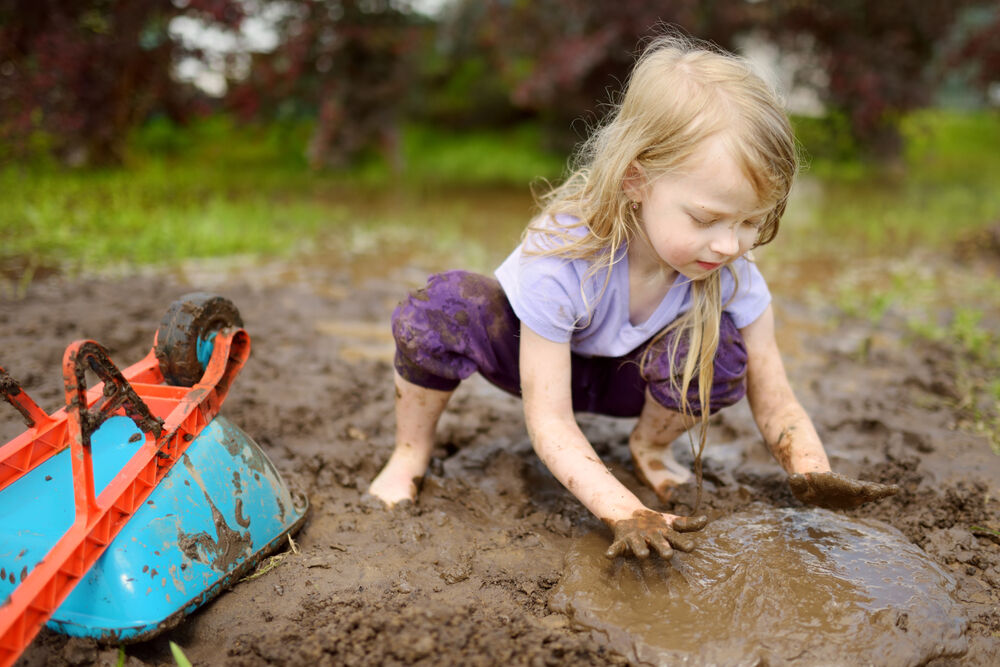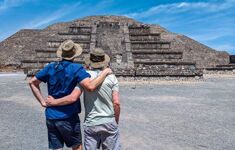Apparently, a lot of Americans are currently anxious and depressed. Meanwhile, their kids are in downright crisis.
Some people say, Well, sure! Look at everything everyone has to deal with! Covid? Inflation? Trump?! Climate change?!!
Related:
Never too late to change your life: Why my husband & I dropped everything to become traveling nomads
Our lives are, in large part, what we make of them. And even if they’re not, I’m really glad my friends and I have at least acted like they are.
The problem with this theory is that my husband, Michael and I have spent the last six years traveling the world, visiting countries far “worse off” than America by almost any objective measure, and people don’t seem nearly so stressed out.
Dive deeper every day
Join our newsletter for thought-provoking commentary that goes beyond the surface of LGBTQ+ issues
Lately, psychologists have begun suggesting alternative theories to explain what’s happening in America — like the fact that thirty years ago, the “typical” childhood was radically reimagined to eliminate most “free time.” Now kids are constantly supervised and monitored in an effort to keep them “safe.”
But the counterintuitive result is that American kids are less likely to learn resilience and inner strength — methods for dealing with their own stress and anxiety.
Spoiler alert: as someone who was a kid more than thirty years ago, I think most of this anxiety is obviously the “helicopter parent” thing. Well, that and smartphones and social media. Duh.
I grew up in a developing suburb, and the area below our neighborhood was still a vast forest with a creek and a swamp. I spent a large percentage of my childhood in that forest — all out of view from or contact with parents or adults, since cellphones hadn’t been invented yet.
There was one area where the creek slowed down and spread out, and there was a large mudflat in the middle of the water that we kids all very imaginatively called Mud Island. My friends and I spent a lot of time mucking around this creek, catching fish and frogs, but no one had ever walked across Mud Island.
Then one day when I was about twelve, I decided I was going to do it.
I put on my rubber boots and fashioned myself a walking stick from an alder branch. My friends gathered on the shore to watch, and I started out across the mud.
Halfway across, I started sinking.
I turned back to shore. “Okay, maybe this wasn’t such a good idea. I’m coming back.”
Problem is, I was stuck. And I was still sinking. It was like quicksand — and the cold mud had already breached my boots.
“Uh, guys?” I said. “I think I’m in trouble.”
“Use your stick,” my friend, Bill said to me. “Push down and push yourself up. It’ll be okay.”
And I did use the stick, but it quickly got stuck too. There was something about the suction of the mud — I couldn’t lift it up again. And now my boots were completely full of mud, which just weighed me down even more.
What was happening here? Was I going to sink into this stuff and die? It was already up to my thighs!
“I can’t move!” I called to my friends. “You guys need to help me.”
For a minute, they all stared back at me, fear on their faces. No one knew what to do in a situation like this. They were just boys and girls — stupid kids like me.
Then Bill kicked into action.
“Strip branches from the trees!” he commanded the others. “Long and thick ones, lots of them. We’ll lie them out across the mud and hold onto the ends. Once Brent pulls himself out, he can crawl back on top of them.”
And I watched, still slowly sinking, while my friends quickly did just as Bill had directed, branch after branch, making a kind of bridge.
When it was done, Bill said to the others, “Hold onto the ends of the branches. No one else go into the mud. The last thing we need is someone else getting stuck.”
Then he looked at me. “Okay, Brent. Just crawl forward. You can do this.”
Sure enough, it was now all on me. I had to somehow crawl over all this mud on some stupid branches? What if I was already too deep in the mud to get out? What if the branches sank when I climbed on top of them?
But no! I couldn’t think about any of this now. I had to just do it.
I let myself fall forward in the mud, grabbed the branches, and I pulled — hard.
I was still stuck. My boots were trapped deep in the mud.
But I kept pulling — and with a loud squelching noise, my feet slipped out of my rubber boots, which stayed behind in the creek.
Then I crawled forward toward the shore. Because there were so many thick branches, I really did stay on top of the mud.
I made it. Bill had been right about everything — thank God he was so smart.
Was I ever really in danger of dying? Probably not; I don’t think the mud was that deep. But it had been plenty scary at the time.
Which is why I said, “Thanks, you guys.” We didn’t hug, and I didn’t cry or anything — I wasn’t a sissy. Plus, I think crying would have made the whole thing seem even scarier than it was.
Looking back, I can see how suppressing my emotions was probably a bad thing in some ways. But it was a good thing in other ways. I was learning how to handle my emotions — discovering that not every feeling needs to be expressed at any given moment. It was okay to be in control.
But I do remember feeling so close to my friends. I now knew for a fact that I could rely on them for anything. Even saving my life.
After that, we all walked up the trail home, me in my stocking feet, and I snuck in through the basement of my house, washing my muddy clothes myself and using the downstairs shower. I never told my parents what happened — just like down at Mud Island, none of us had ever even considered going to adults for help. They were adults, and we were kids, and back then, those were two completely different worlds.
Looking back, I can also see how that massive dividing line between the world of adults and the world of kids was probably a bad thing in some ways. But it was an incredible thing in other ways. We kids were almost entirely on our own. So we had to figure things out for ourselves — even serious, scary things.
But I was learning confidence and resilience — and friendship. Together, my buddies and I could figure out the solutions to our problems. The risk was what made it real.
Incidentally, that walking stick that I had carried with me halfway across Mud Island that ended up stuck out in the mud? Because the stick had been so fresh, it took root in the mud, and I spent the rest of my childhood watching it grow into a massive tree, larger and larger every year, stronger and sturdier.
This tree would be a good metaphor for how formative that experience on Mud Island was for me, how I grew stronger too. And my rubber boots are probably still down there in that mud, left behind like my foolish, distant childhood.
Except the experience wasn’t really that formative. It wasn’t like in that movie Stand By Me, where the kids go on an overnight hike that becomes a pivotal coming-of-age experience for all of them.
The fact is, when I was a kid, s**t like what happened down at Mud Island happened all the time. I could also tell you about the time when Bill, Ann, and I accidentally set a field on fire, and we had to somehow put it out again before the adults noticed — Bill saved us then too. Or the time another friend, Elliott, was being bullied so viciously, I met privately with a third friend to figure out a plan to cheer Elliott up, to keep him from doing something really stupid.
Oh, I was also a closeted gay kid in the 1980s. Seriously, that was no picnic.
But no adult ever helped me with any of this.
In writing this article, I texted Bill and asked if he remembered anything more about that afternoon at Mud Island. Yeah, forty-plus years later, we’re still in touch. I mean, come on, the guy kinda saved my life.
Bill obviously remembered Mud Island, but he had no memory of my ever getting stuck.
Now, granted, getting stuck happened to me, not him.
But still. This really was just another day in the life of some American kids in the 70s and 80s.
If you’re an American who wasn’t alive back then, this all might seem unimaginable to you. But I swear, it was completely normal, even for kids with control freak moms like mine — easily, the most nervous parent on the block.
This is the way it still is in most of the rest of the world.
This is the part about life that coming-of-age movies always get wrong: there is no one moment when you come of age. Nah. It’s an ongoing process, a bunch of little moments and things.
This process — all the frustrating or scary challenges we overcome, and all the deep bonds we make with the people helping us do it — is what hopefully turns us into functioning adults.
A few years later, as a teenager, I had to figure out even scarier s**t — things like drugs and guns and sex, and even the death of a close friend. But by then, I was ready. I’d faced down Death before — kind of.
To be very clear, there were lots of parts of my childhood — of life back in the 70s and 80s — that were just outright bad. The world has improved in so many important ways.
And I know that new treatments and accommodations have been revolutionary for people with specific problems and anxieties.
But it truly saddens and concerns me that many of today’s kids aren’t allowed the incredible freedom my friends and I had — to do really stupid things, to be truly scared deep down in our guts, but then to somehow get it together and figure it all out. And to learn how amazing that feels.
I’m an adult now, standing on my own two feet. But before I could stand, I had to learn to crawl, which I did with the help of my childhood friends, following Bill’s quick-witted idea to lay a bunch of branches across the surface of Mud Island.
Brent Hartinger is a screenwriter and author, and one-half of “Brent and Michael Are Going Places,” a couple of traveling gay digital nomads. Subscribe to their free travel newsletter here.


















